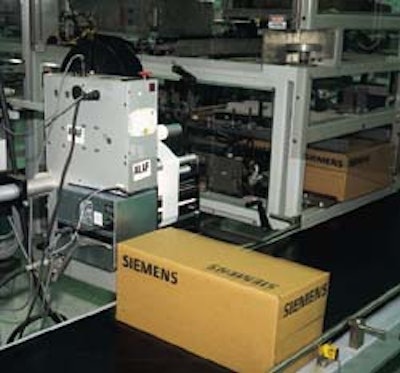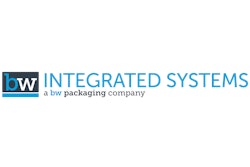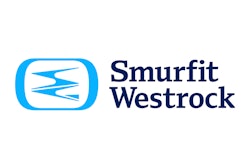Siemens of Munich, Germany, is among the leading manufacturers of cordless phones for small-office and residential settings. Its phones operate on a 2.4-GHz frequency that Siemens says offers sound quality unmatched by older cordless-phone technologies.
Demand for Siemens’ phone products is so great that the company has begun automating manufacturing operations, including packaging, in its Austin, TX, phone-making plant. For two identical packaging lines installed last fall, turnkey responsibility was in the hands of Smurfit-Stone (Orlando, FL). The lines replaced manual operations, each of which used to require three or four operators who packed about four phone kits/min. Now just one operator is required per line, and speeds are comparable.
“One package every 15 seconds, that’s our goal on each line,” says process engineer Victor Mares.
Also part of the picture, says Mares, is rapid changeover in going from one phone to another. Corrugated tray design provides a good example. Even though there are a total of six phone varieties, there are only two tray sizes. Internal die cuts in the trays come in four varieties, but outside dimensions number just two. “That minimizes changeover time when we go from one phone to another,” says Mares.
Without a tray-size change, the operator only needs to empty and reload the magazine holding the corrugated tray blanks. Machine settings can remain as they are. When tray sizes do change, it takes about 30 minutes to complete a line changeover. Most of it is accomplished with hand cranks and levers, not tools.
Three main machines
Each line includes three pieces of equipment made by Smurfit-Stone: corrugated tray former, retail-box erector and corrugated case packer. Each of these machines includes a hot-melt glue system from Nordson (Duluth, GA).
First in each line is the Series 4400 corrugated tray former. It pulls a flat blank out of a magazine and positions it beneath a mandrel that pushes the blank through a series of forming rails and glue stations until the blank is a formed, glued tray.
“It’s a big improvement over the hand-taping we used to do,” says Mares. “It’s so much more solid.”
Supplied by Smurfit-Stone, trays are made of either 275# or 200#-test, B-flute corrugated. Die-cutting and scoring have to be dead on, says Mares, for the blanks to behave properly in the automated machine and for the phone components to fit snugly enough not to fall out. “We went through a number of iterations on those,” says Mares.
Trays are discharged onto a Hytrol (Jonesboro, AR) powered roller conveyor that makes a gradual 90° turn and then hands the trays to an incline belt conveyor. Near the beginning of this 5’ belt conveyor is a photocell. If trays back up to that point, the photocell detects them and signals the PLC to halt tray forming until the backup clears.
Next in line is the station at which the lone operator is positioned. Conveyed to him are base units assembled upstream, and surrounding him are totes filled with hand sets, power supplies and battery packs. The operator places each of these items in the appropriate die-cut on the corrugated tray and then places the tray on another conveyor leading to the Rap-A-Mat 350 wraparound system.
Photocell detection
A photocell detects if the tray size is wrong or if the operator has put the tray on the conveyor wrong-side first. Should this happen, an alarm sounds.
As a tray enters the Rap-A-Mat 350, it’s elevated and then swept at a right angle onto a flat box blank fed from a magazine. A pick-and-place machine supplied by Streamfeeder (Minneapolis, MN) places a publication insert on top of the phone components. Then, two vacuum cups stroke up from below the box blank and pull it down through forming guides so that it folds along the right scores. Hot melt is applied, and pneumatic devices push the flaps closed. With that, the finished box drops onto a powered roller discharge conveyor that gently turns 90° to the left.
Again from Smurfit-Stone, the retail boxes are made of 200#-test, E-flute corrugated and have a linerboard preprinted offset in five colors. Just as the corrugated phone trays were carefully designed so that only two exterior dimensions are required for all six phone varieties, the retail boxes come in only two sizes. The attractive graphics are intended to grab attention at Office Depots and similar retail outlets. (The phones are also sold through resellers and distributors.) Suggested retail price on the most sophisticated of the phones is $399.
A belt conveyor picks up the retail boxes as they leave the Rap-A-Mat 350 and carries them to an Icore Autocheck 8000 checkweigher from Ramsey (Minneapolis, MN). If any component is missing, the checkweigher detects it and sends that box down a reject spur.
“The checkweigher is especially helpful in the beginning of a shift or when a new worker is loading components into trays,” says Mares. “Also, we have the checkweigher set so that if three packages in a row are rejected, the line shuts down.”
Printing on-line
Immediately after the checkweigher is a thermal-transfer, tamp-style, print-and-apply labeler from Lord Label (Arlington, TX). Some retail boxes must carry variable information, and Siemens didn’t want to inventory more varieties of preprinted blanks than was absolutely necessary. So the variable information is printed on a white, pressure-sensitive, polyethylene label and applied on-line. A bar-code scanner scans the UPC on the label, and if the wrong label has been applied, the box is rejected.
From the Lord labeler, boxes are conveyed into a Rap-A-Mat 350XL, a heavier-duty version of the Rap-A-Mat machine that handles the retail box. Four boxes are encased in a 275#-test, B/C-flute, double-wall corrugated case, once again from Smurfit-Stone, and sealed with hot melt. A print-and-apply Lord labeler like the one upstream tamps a label—with shipping code, product identification and quantity—onto one end of the case. All that remains is manual palletizing.
“The finished case is nice and clean and sturdy,” says Mares. “With the manual operation it was only as good as you could make it with tape guns.”
But it’s the reduction in labor costs that is most impressive. “There’s a huge savings in moving away from manual packaging,” says Mares. That’s why the company expects to see a return on its investment in less than a year, he adds.
This summer, the automation initiative at Siemens will bring in two more automated phone-assembly lines and a third packaging line just like the two already installed. When this phase is complete, each packaging line will be fed by an automated assembly line. Siemens will be able to schedule any one of its eight phone varieties on any one of the packaging lines.
Considering that the first two packaging lines were installed only last fall and the third is scheduled for this summer, Mares says he’s pleased to have come so far so fast. He’s quick to credit Smurfit-Stone for its execution on the turnkey project.
“We gave them our requirements and they lined up the equipment,” says Mares. “In some areas we gave them more specs than others, but in the end they met all our needs. They’re one of the best suppliers I’ve ever worked with on a major project like this.”
In a hurry? Request more info via Web-based reader service by clicking on the reader service number.
Or you can jump right to their Web site.

































